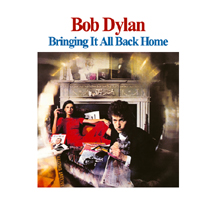BRINGING IT ALL BACK HOME 
In like manner, I don’t view the release of Another Side of Bob Dylan as a radical break from the past, but rather a natural evolution of his music. For that matter, I feel the same way about Bob Dylan’s “going electric” on his next two albums, Bringing it All Back Home and Highway 61 Revisited; and also his Christian period in the trilogy of albums from 1979-1981: Slow Train Coming, Saved, and Shot of Love. Bob Dylan is very much undervalued as an instrumentalist, in my judgment; his guitar playing – and his harmonica, and his work as a pianist – is so strong that I often don’t even notice whether a song is acoustic or electric. As an example, until I saw it pointed out in Wikipedia while I was researching this month’s post, I had not realized that one of my Top Ten favorite Bob Dylan songs – the last and longest track on Highway 61 Revisited, “Desolation Row” – was the only non-electric song on the album.
(May 2013)
* * *
Besides the work on Freewheelin’, Tom Wilson wound up producing many of the albums that make up the heart of Bob Dylan’s early career: The Times They Are A-Changin’, Another Side of Bob Dylan, and Bringing it All Back Home.
(June 2013/2) * * * Joan Baez in Concert, Part 2 (1963) included the first Bob Dylan songs that she recorded, “Don’t Think Twice, it’s All Right” and “With God on Our Side” – she says that the latter song is the first Dylan song that she learned. Joan Baez and Bob Dylan were starting to become closely associated with one another (and perhaps romantically) as the two leading folk artists of the day; a few months prior to the release of this album, the two had appeared at the 1963 March on Washington, and Bob and Joan were photographed together on the back cover of his album Bringing it All Back Home (1965).
(February 2014)
|